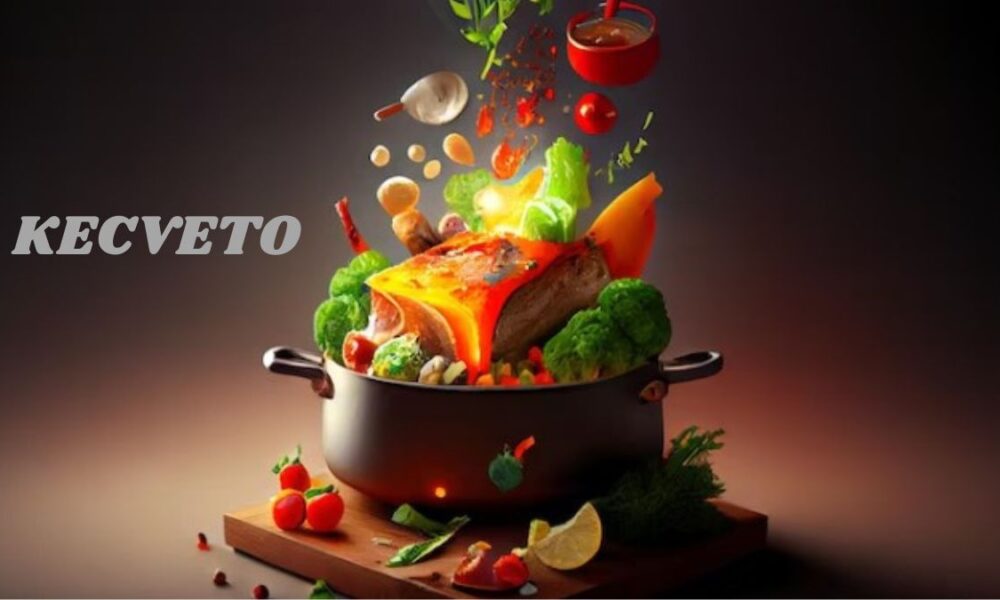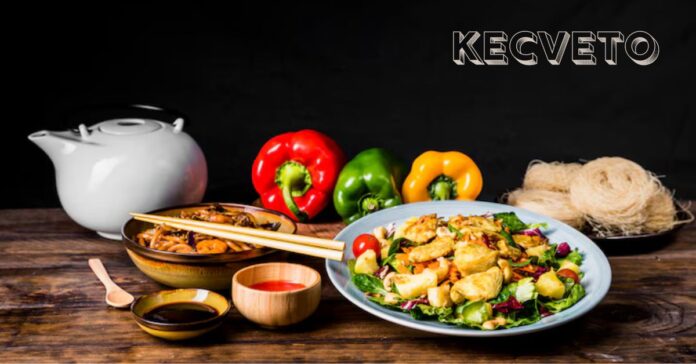The Kovach of Turkish home-made cuisine is basified, a distinctive stew eaten with relish, which limits the traditional Turkish stews. This meal, which can be enjoyed with juicy pieces of meat and a beautiful court of vegetables that have all been with a spicy stock of spices, brings forth the soul of Turkish culture. Dating back to the Ottoman era, Kecveto has been an important virtue, and our ancestors have long savored it and passed it from one generation to another.
However, it is not the same anymore and has evolved as human knowledge and civilization improved, yet it has always been a delicacy and nutritious. It is traditionally made with lamb or beef, though variations might include chicken or veal, each choice deeply influencing the stew’s final taste and texture.
The vegetables typically used—onions, tomatoes, peppers, and eggplants—contribute not only vital nutrients but also layers of flavors that meld beautifully as the stew slowly cooks.
The spices, including paprika, cumin, and sometimes turmeric, are what give Kecveto its distinctive, tantalizing aroma and deep, complex flavor profile. This dish isn’t just food; it’s a culinary journey through the heart of Turkish history and society, served up in a bowl of rich, savory stew that comforts as much as it nourishes.
The Rich History of Kecveto
The historical journey of Kecveto begins in the robust kitchens of the Ottoman Empire, where it was initially crafted to fuel soldiers with energy and resilience for their battles. This context is crucial as it reflects the dish’s hearty and filling nature, designed to sustain individuals through demanding circumstances. Over the centuries, Kecveto transitioned from military camps to become a beloved fixture in everyday Turkish cuisine.
Each region of Turkey may have introduced its twists on the recipe, but the core ingredients remained consistent, symbolizing a unifying culinary tradition amidst diverse cultural practices. The evolution of Kecveto also mirrors significant historical and social changes within Turkey, adapting to the shifting dynamics of dietary needs, availability of local ingredients, and the influences of neighboring cultures.
Today, while Kecveto continues to be a symbol of Turkish hospitality and tradition, it also operates as a testament to the country’s rich history. This dish has nourished countless generations and stands as a pillar of national cuisine.
What Makes Kecveto Unique?
The uniqueness of Kecveto lies in its carefully selected ingredients, each adding layers of flavor and texture that make this dish distinctly Turkish. The choice of meat is the foundation—typically lamb or beef, cut into hearty chunks that tenderize beautifully through slow cooking, enriching the stew with a robust flavor.
Vegetables play a crucial role; tomatoes provide a tangy sweetness, onions add a subtle sharpness, and green peppers offer a slight bitterness, all harmonizing within the stew.
Eggplants, another common addition, absorb flavors and spices while contributing a creamy texture. The main secret ingredient often is a mixture of spices, e.g., paprika for a hint of heat, cumin for its smokiness, and garlic for the relish – it is a blend that not only makes the stew rich but also provides balanced flavors that are strong, yet in delicate balance with their natural taste.
Their very association is not the only thing; it is the intertwining that is the highest part; step by step, they complement each other when the kitchen is simmering for hours, thus presenting a stew that is rich, complex, and, of course, Turkish is one as well.
Kecveto’s preparation is a real kind of art, expressing the spirit of traditional Turkish cuisine, in which flavor and sweetness are essential. We like to share our food, so we always do it in a communal setting.
The Art of Making Kecveto
The traditional preparation of Kecveto is an art form that showcases the culinary craftsmanship inherent in Turkish cooking. This dish is not hastily made; it requires patience and precision, emblematic of a cooking style that values slow food and deep flavors. The process begins with browning the meat—lamb, beef, or sometimes chicken—to develop a rich flavor foundation.
Then, there comes sauteeing of onions and garlic until they are translucent, creating a bed of aromatic products that will gradually scent the stew. First, vegetables and spices are mixed. Each ingredient always enters next and never the first to guarantee the texture and flavor of every other ingredient.
The stew is then simmered so that the meat will tender and the flavors merge. The whole cooking process is flexible like that— if an ingredient might be added or taken out, or some broth could be poured in to be able to cook to the desired thickness and taste.
It is so as he finds a systematic method of cooking indispensable. This approach gives the desired outcome stew that is not simply flavorful and harmonious but rather tasty and complex. It takes a few hours for flavors to respond.

Regional Twists on Classic Kecveto
Kecveto, while deeply traditional, is also a canvas for regional creativity within Turkey. Different regions of the province have variations created by other chefs and home cooks. They are a reflection of their authentic cultural and geographical influences.
Some areas feature the modification of the soup with carrots and potatoes included; a flavor that is sweet and somehow earthy with a thicker texture is created with these ingredients.
Apart from the mentioned ingredients, the usage of other ingredients might include chicken or fish, which are less common but could be relevant to the different traditions and local tastes of the people. Though spices would also differ in terms of variety, they do as other chefs might sprinkle some cinnamon for warmth and hot pepper flakes for a spicy flavor according to the local taste.
These regional variants not only add diversity to the traditional recipe of Kecveto but also tell the story of Turkey’s culinary diversity, where each locale imparts its signature touch to create a version of Kecveto that reflects its own identity and tradition. This adaptability of Kecveto underscores its role as a beloved dish throughout Turkey, cherished for its ability to embrace and express local flavors and ingredients.
Health Benefits of Eating Kecveto
Kecveto is not only a feast for the senses but also a boon for health, offering a variety of nutritional benefits that make it a wise choice for a balanced diet. Rich in high-quality protein from its meat, Kecveto supports muscle repair and growth, making it particularly nourishing.
Not only do the vegetables provide essential vitamins and minerals; for instance, the tomatoes are loaded with vitamin C and lycopene, the onions contain quercetin, and the green peppers are a good source of antioxidants.
The spices that are used, like turmeric and cumin, are known for their anti-inflammatory properties, and they serve a role in boosting immunity, strengthening the digestive system, and lowering levels of inflammation. Moreover, this permits slow-cooking up to the time when all the nutrients of all the ingredients are retained so that the process is as beneficial to health as possible.
If you are one of those who are paying attention to your calorie intake, Kecveto is the one that will greet all of you with a nourishing plate without going overboard with your calorie intake.
The calories follow upon the choice to use lean cuts of meat, and the must be minimum use of oil. This makes Kecveto a smart choice for anyone looking to enjoy a flavorful meal that supports overall health.
Why Kecveto is More Than Just Food
Kecveto holds a special place in Turkish culture, transcending its role as mere sustenance to become a symbol of hospitality and community. In Turkey, food is one of the elements of the culture. Sharing food represents connecting, especially during the holidays or religious holidays.
Kecveto is frequently found on these occasions, to be exact, mostly during the holidays and Christmas. The food’s potential to bring people together, regardless of their ethnicity, habit, belief, or even religion, tells of its cultural significance.
It is usually ready when it has been prepared in large amounts to eat at the same time with other family members, friends, and even neighbors, which builds feelings of belongingness and unity.
The kekveto preparation process is a social activity in which different family members actively participate in food production, thereby strengthening ties and instilling culinary skills in successive generations through verbal exchanges.
Moreover, its presence at the dinner table during significant events underscores its role in the ceremonial aspect of Turkish life, acting as a comfort food that evokes memories and helps forge new ones.
Discovering Kecveto in Turkish Restaurants
For those looking to experience the authentic taste of Kecveto, Turkish restaurants provide an excellent introduction. Chefs in these establishments take pride in crafting Kecveto using traditional recipes that highlight regional flavors and cooking styles.
Those who do come to Kecveto should do so while anticipating the fruit of the day’s harvest.
These vegetables simmer to release the flavors just as many restaurants create their fleets of Nasi Goreng signature ingredients or techniques that only make the original profile to be even better. Eating a Kebab in a Turkish restaurant not only gives you an exquisite meal, but you also experience a journey through Turkey’s colorful, as well as unique, gastronomic culture.
It is not only the way diners enjoy the Turkish menu but also encourages them to interact with staple cultures and appreciate the richness and complexity of this traditional dish.
Tips for Crafting the Perfect Stew at Home
Making Kecveto at home allows for personalization and experimentation, turning the traditional stew into a tailored culinary experience. Start by selecting quality ingredients, as fresh and high-quality meats and vegetables form the backbone of a flavorful Kecveto. The browning of meat imparts a deep, rich flavor to the stew.
At the same time, the sautéing of onions and garlic to a golden color creates not only a fragrant aroma but also a flavor that is already mouthwatering. Due to the fact that the vegetable is introduced at the right point, it will not be overcooked, and it will absorb the spices much better. Slow cooking is the essence of it all; it binds all the flavors together while making the meat tender, so the key is patience, and I must admit that it certainly makes things harder.
Therefore, if you have a typical taste – incorporate the ingredients that you like best and mean the singularity to a local region you live in, like different fresh herbs or a sea of local wine for more depth.

Selecting the Right Ingredients for Authentic Kecveto
The authenticity of Kecveto hinges significantly on the choice of ingredients. However, the authenticity of the stew mostly depends on the kind of ingredients you can find in the market. The best option would be for you to go for meat of the finest quality, i.e., lamb or beef that is evenly marbled with amounts of fat in it; this will improve both the stew’s essence and tenderness during slow cooking.
The veggies should look juicy and vibrant, and each one should add its special element to the meal. Spices like fresh paprika and cumin, which are usually used in traditional recipes, must be of the highest quality to be used. Another way of getting a real taste of Turkish spirit is by using regional spices that you cannot find in other places, but they are an integral part of Turkish cuisine.
These can be searched, and they can either be picked at the market specializing in them or the international stores. By being meticulous in selecting ingredients, you ensure that your Kecveto not only tastes rich and satisfying but also remains true to its Turkish roots.
How to Prepare Kecveto
Preparing Kecveto at home can be a delightful culinary task. Here’s a step-by-step directory to help you create this Turkish stew:
- Prepare the Ingredients: Begin by chopping your vegetables—onions, tomatoes, green peppers, and eggplants—into uniform pieces. Cut the meat into bite-sized chunks.
- Brown the Meat: Warm a large pot over medium-high warmness. Add some oil and sear the meat pieces until they are golden on all sides. This process locks in flavors and enhances the stew’s savoriness.
- Sauté the Vegetables: Remove the meat and add onions and garlic to the pot. Cook until they are soft and translucent. Then add the remaining vegetables and sauté them lightly.
- Combine and Simmer: Return the meat to the pot. Add your spices—paprika, cumin, and any other desired seasonings—along with enough broth to cover the ingredients. Bring the mix to a boil, then decrease the heat and let it simmer, covered, for at least two hours.
- Adjust Seasonings and Serve: As the stew cooks, check the flavors and adjust the seasonings as needed. Once the meat is tender and the vegetables are boiled to your liking, the Kecveto is ready to be served.
This process, while time-consuming, is deeply rewarding, offering a stew that is robust, flavorful, and comforting.
dapting Spices and Ingredients
Kecveto is quite versatile, as it can be adapted to anyone’s palate based on their dietary preferences, use, and taste profile. The modification of the dish’s spices is among the most straightforward and effective methods of customizing. Feel free to make it easier by adding chili flakes or chopped chilies.
If you want to add a fresh, herby taste, add bay leaves or thyme to your recipe. Along with the quantity of meat, the types of meat used can also create a difference in the dish’s taste – fish instead of chicken for lightness or chicken instead of lamb for different flavors may be used. Vegetables may be changed based on regional availability or individual desires, and the diversity can be enhanced with squash or mushrooms, which are an amazingly large source of new flavors and textures.
This adaptability is one of the reasons why Kecveto has become the main dish that visitors can enjoy at any time of the year rather than the one that elicits boredom owing to its stagnancy every year.
Best Accompaniments for Kecveto
While Kecveto is a flavorful and satisfying dish on its own, serving it with complementary accompaniments can elevate the dining experience further. Here are some traditional and contemporary options to consider:
- Rice: A classic pairing, steamed rice serves as a neutral base that allows the taste of the Kecveto to shine. Opt for long-grain varieties like basmati or jasmine rice for a fragrant addition to your meal.
- Bread: Turkish bread, such as pide or lavash, is perfect for washing up the rich broth of the Kecveto. Tear off a piece and use it to scoop up the tender meat and vegetables, savoring every bite.
- Yogurt: A dollop of creamy yogurt adds a refreshing contrast to the hearty stew. Its tanginess helps balance the richness of the Kecveto and provides a cooling element to the meal.
- Salad: A fresh salad of greens, tomatoes, cucumbers, and herbs serves as a light and crisp counterpart to the robust flavors of the Kecveto. A simple vinaigrette or lemon juice dressing complements the dish beautifully.
- Pickled Vegetables: Tangy pickled vegetables, such as cucumbers, carrots, and cabbage, offer a burst of acidity that cuts through the richness of the stew, providing a refreshing palate cleanser between bites.
- Turkish Meze: A selection of Turkish mezes, such as hummus, baba ghanoush, and pressed grape leaves, makes for a delightful appetizer or accompaniment to Kecveto, adding variety and depth to the meal.
- Herbs and Lemon: Garnish the Kecveto with fresh spices like parsley or cilantro and a squeeze of lemon juice to illuminate the flavors. Add a shot of freshness per spoonful.
These serving suggestions cater to different tastes and preferences, allowing you to create a well-rounded and memorable dining experience centered around Kecveto.
Kecveto Across the Globe
While Kecveto originated in Turkey, its popularity has spread far beyond its borders, finding a place in the hearts—and stomachs—of people around the world. Turkish immigrants and diaspora communities have introduced Kecveto to new countries, where it has been embraced and adapted to local tastes and ingredients. In Germany, for example, Kecveto has become a favorite among Turkish communities, often served alongside traditional German fare at family gatherings and celebrations.
In the United States, Turkish restaurants and food trucks offer Kecveto to curious diners eager to explore the flavors of the Mediterranean. Even in countries where Turkish cuisine may be less well-known, adventurous cooks are discovering Kecveto through online recipes and culinary blogs, intrigued by its rich history and tantalizing flavors.
This global appreciation for Kecveto speaks to its universal appeal and enduring legacy as a beloved dish that transcends cultural boundaries.

The Future of Kecveto in Turkish Cuisine
As Turkish cuisine continues to evolve and adapt to changing tastes and trends, the preservation of traditional dishes like Kecveto becomes increasingly important. While modern interpretations and innovations have their place, it is essential to honor the roots and heritage of Turkish cooking by safeguarding recipes and culinary techniques passed down through generations.
This includes not only preserving the flavors and ingredients that define Kecveto but also the cultural rituals and social significance associated with the dish. Initiatives to promote and celebrate Turkish cuisine, such as culinary festivals and educational programs, play a vital role in ensuring that dishes like Kecveto remain an integral part of Turkey’s culinary identity.
By embracing tradition while embracing innovation, Turkish cuisine can continue to thrive and encourage future generations of chefs and food enthusiasts, ensuring that dishes like Kecveto endure as timeless treasures of Turkish gastronomy.
Conclusion
In conclusion, Kecveto is a culinary masterpiece deeply entrenched in Turkish heritage, symbolizing centuries of tradition, cultural exchange, and culinary craftsmanship. Through this exploration, we’ve delved into its rich history, essential ingredients, and diverse variations, uncovering the layers of flavor and cultural significance that make it a beloved dish both in Turkey and around the world.
From its origins in the kitchens of the Ottoman Empire to its modern-day presence on tables in Turkish homes and restaurants worldwide, Kecveto has endured as a testament to Turkey’s rich culinary heritage. Its evolution over time reflects the dynamic nature of Turkish cuisine, adapting to changing tastes and regional influences while remaining rooted in tradition.
At the heart of Kecveto lies the art of slow cooking and the careful selection of ingredients—tender meat, vibrant vegetables, and aromatic spices—that come together to create a symphony of flavors and textures. Whether enjoyed in a traditional Turkish household, a bustling restaurant in Istanbul, or a home kitchen halfway across the world, Kecveto is more than just a meal; it’s a connection to the past, a celebration of community, and a source of comfort and nourishment.
Furthermore, Kecveto serves as a bridge between cultures, surpassing borders and bringing people together through the universal language of food. Its global popularity is a testament to its versatility and appeal, as well as to the enduring legacy of Turkish cuisine on the world stage.
As we look to the future, preserving the tradition of Kecveto and other iconic Turkish dishes is paramount. This requires safeguarding recipes and culinary techniques and honoring the cultural rituals and social significance associated with these dishes. By doing so, we ensure that future ages can continue to savor the flavors of Kecveto and share the rich tapestry of Turkish gastronomy.
In the end, Kecveto is more than just a stew; it’s a culinary delight that embodies the essence of Turkish culture, history, and hospitality. Whether shared with loved ones during festive groups or savored alone on a quiet evening, Kecveto will continue to captivate hearts and palates for generations to come, serving as a timeless symbol of Turkey’s culinary prowess and cultural richness.
Also Read About: Embracing Alevemente: Transform Your Mental Wellness
FAQ’s
What is the origin of Kecveto?
Kecveto originated in Ottoman cuisine and has been enjoyed for centuries in Turkish culture.
What are the key ingredients in Kecveto?
The key ingredients in Kecveto include meat, vegetables, and a blend of spices.
Is Kecveto difficult to make at home?
While Kecveto requires some time and effort to prepare, it can be made at home with relative ease.
Can Kecveto be made with different types of meat?
Yes, depending on personal preference, Kecveto can be made with different kinds of meat, such as lamb, beef, chicken, or veal.
What is the best way to serve Kecveto?
Kecveto is traditionally served with rice or bread and can be accompanied by a salad or yogurt on the side.
Are there any vegetarian or vegan alternatives to Kecveto?
While the traditional Kecveto recipe contains meat, vegetarian or vegan versions can be made using plant-based substitutes such as tofu or tempeh, along with a variety of vegetables and vegetable broth.
What is the significance of Kecveto in Turkish culture?
Kecveto holds a special place in Turkish culture and is often served during special occasions and gatherings as a symbol of hospitality and warmth, fostering a sense of community and togetherness.
Are there any regional variations of Kecveto in Turkey?
Yes, there are regional variations of Kecveto across Turkey. Different provinces add their unique ingredients or spices to the traditional recipe, resulting in diverse flavor profiles and cooking techniques.
Can Kecveto leftovers be repurposed into other dishes?
Absolutely! Leftover Kecveto can be repurposed into various dishes such as sandwiches, wraps, or even pasta sauces, delivering a tasty and suitable way to enjoy the flavors of Kecveto in new and creative ways.



